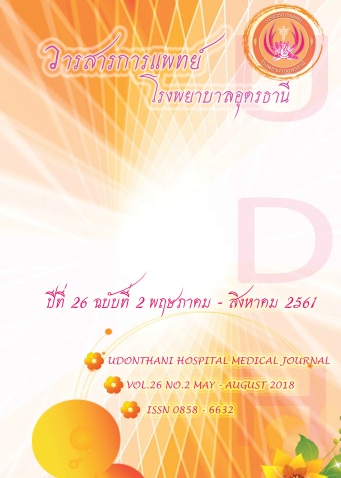ผลของโปรแกรมการส่งเสริมพัฒนาการด้านภาษาของเด็กอายุ 2-3 ปี: การศึกษาเบื้องต้น*
คำสำคัญ:
พัฒนาการด้านภาษา, โปรแกรมการส่งเสริมพัฒนาการด้านภาษา, เด็กอายุ 2-3 ปีบทคัดย่อ
หลักการและเหตุผล : พัฒนาการเด็กในช่วงอายุ 2-3 ปีมีความสำคัญมากพร้อมเปิดรับข้อมูลข่าวสารมากที่สุดทำให้เกิดการเรียนรู้ได้เร็วเป็นจุดเริ่มต้นของการสื่อสารเพื่อเข้าสังคมจึงได้เล็งเห็นความสำคัญในการส่งเสริมพัฒนาการด้านภาษาโดยการจัดโปรแกรมการส่งเสริมพัฒนาการด้านภาษาขึ้นมา
วัตถุประสงค์ : เพื่อศึกษาผลของโปรแกรมการส่งเสริมพัฒนาการด้านภาษาของเด็กอายุ 2-3 ปีต่อพัฒนาการด้านภาษาของเด็ก
รูปแบบการศึกษา: การวิจัยกึ่งทดลองแบบกลุ่มเดียววัดก่อนและหลังการทดลอง
สถานที่ศึกษา: สถานเลี้ยงเด็กแห่งหนึ่งในโรงพยาบาลส่งเสริมสุขภาพจังหวัดขอนแก่นทำการศึกษาตั้งแต่วันที่ 17-27 เดือนเมษายน พ.ศ. 2561
กลุ่มตัวอย่าง : เด็กอายุ 2-3 ปีที่มีพัฒนาการด้านภาษาสงสัยล่าช้าโดยใช้เครื่องมือการประเมินพัฒนาการเด็กปฐมวัยไทย (Denver II) ฉบับภาษาไทยจำนวน 5 คน
วิธีการศึกษา : เด็กที่มีพัฒนาการด้านภาษาสงสัยล่าช้าจะได้รับโปรแกรมการส่งเสริมพัฒนาการด้านภาษาโดยใช้ทฤษฎีการเรียนรู้ทางปัญญาสังคมของแบนดูราผ่านหนังสือนิทานประกอบภาพชุดบัตรคำและเกมต่อภาพ
การวัดผล : การประเมินพัฒนาการด้านภาษาด้วยแบบประเมิน Denver II ฉบับภาษาไทยและแบบประเมินการเข้าใจภาษาและการใช้ภาษาของเด็กอายุ 2-3 ปีและวิเคราะห์ข้อมูลด้วยการแจกแจงความถี่ร้อยละค่าเฉลี่ยส่วนเบี่ยงเบนมาตรฐาน 95% CI และ Paired t-test
ผลการศึกษา : เด็กอายุ 2-3 ที่มีพัฒนาการด้านภาษาสงสัยล่าช้าหลังเข้าร่วมโปรแกรมการส่งเสริมพัฒนาการด้านภาษาพบว่ามีพัฒนาการด้านภาษาปกติด้วยเครื่องมือ Denver II จำนวน 4 คน (ช่วงความเชื่อมั่น 95% เท่ากับ 0.64-1.76) และมีค่าเฉลี่ยของคะแนนการเข้าใจภาษาและการใช้ภาษาของเด็กอายุ 2-3 ปีสูงกว่าก่อนเข้าร่วมโปรแกรมอย่างมีนัยสำคัญทางสถิติที่ระดับ 0.05
*บทความวิจัยนี้เป็นส่วนหนึ่งของวิทยานิพนธ์เรื่องผลของโปรแกรมการส่งเสริมพัฒนาการด้านภาษาของเด็กอายุ 2-3 ปีในศูนย์สาธิตการพัฒนาเด็กคณะพยาบาลศาสตร์มหาวิทยาลัยขอนแก่น
References
2. Cobb NJ. The Child: infants, children, and adolescent. Mountain View: Mayfield Publishing Comp; 2001.
3. Centers for disease control and prevention. Child development: Toddlers (2-3 years of age) [Internet]. 2017 [cited 2017 June 30]. Available from: https://www.cdc.gov
4. Erikson, EH. Childhood and society. 5th ed. New York: W.W. Norton; 1991.
5. Paul R, Norury FC. Language disorders from infancy through adolescence: listening, speaking, reading, writing, and communicating. 4th ed. St. Louis: Mosby; 2014.
6. Hockenberry, JM. Wilson, D. Winkelstein, L.M. Wong’s essentials of pediatric nursing. 7th ed. Missouri: Mosby; 2005.
7. Buschmann, A. Jooss, B., Rupp, A., Dockter, S. Blaschtikowitz, H. Heggen, I., et al. Children with developmental language deley at 24 months of age: results of a diagnostic work-up. DMCN 2007; 50: 223-229.
8. Miniscalco, C. Nygren, G. Hagberg, B. Kadesj, B. Gillberg, C. Neuropsychiatric and
neurodevelopmental outcome of children at the age 6 and 7 years who screened positive for language problems at 30 months. DMCN 2006; 48: 361-366.
9. World Health Organization. Early childhood health [Internet]. 2017 [cited 2017 June 30]. Available from: http://www.who.int
10. นิตยา คชภักดี. พัฒนาการเด็กปฐมวัยและการประเมิน. กรุงเทพฯ: สถาบันแห่งชาติเพื่อการพัฒนาเด็กและครอบครัว; 2560.
11. กรมอนามัยกระทรวงสาธารณสุข. รายงานประจำปีกรมอนามัย 2558 [อินเตอร์เน็ต]. [เข้าถึงเมื่อ 15 มิถุนายน 2560].เข้าถึงได้จาก: http://planning.anamai.moph.go.th
12. พนิต โล่เสถียรกิจ. พัฒนาการเด็กปฐมวัยไทย [อินเตอร์เน็ต]. 2557 [เข้าถึงเมื่อ 15 มิถุนายน 2560]. เข้าถึงได้จาก: http://www.hpc.go.th
13. สุพัฒนา บุญเจียม, วันเพ็ญ ศิวารมย์, เยาวรัตน์ รัตน์นันต์, สิริมา พรราศพัฒน์. สถานการณ์พัฒนาการเด็กปฐมวัยไทยเขตสุขภาพที่ 7. ว.ศูนย์อนามัยที่ 7 ขอนแก่น 2559; 18: 15-29.
14. กรมอนามัยกระทรวงสาธารณสุข.รายงานประจำปีกรมอนามัย 2559 [อินเตอร์เน็ต]. 2559 [เข้าถึงเมื่อ 15 มิถุนายน 2560] เข้าถึงได้จาก: http://planning.anamai.moph.go.th
15. Bandura, A. Self-efficacy: The exercise of control. New York: W.H. Freeman and Company; 1997.
16. Conner J, Vance LK, Ryalls B, Friehe M. A play and language intervention for two-year-old children: implications for improving play skills and language. JRCE 2014; 28: 221-237.
17. Dickinson DK. Porche MV. Relation between language experiences in preschool classrooms and children’s kindergarten and fourth-grade language and reading abilities. Child Dev 2011; 82: 870-886.
18. Dunst JC, Simkus A, Hamby WD. Effects of reading to infants and toddlers on their early language development. CELL 2010; 5: 1-7.
19. Hindman A, Wasik, B, Erhart A. Shared book reading and head start preschoolers’ vocabulary learning: The role of book-related discussion and curricular connections. Early EducDev 2012; 23: 451-474.
20. Roberts MY. Kaiser AP. Early intervention for toddlers with language delays: arandomized controlled trial. Pediatrics2015; 135: 686-693.
21. Wake, M., Tobin S, Girolametto L, Ukoumunne OC, Gold L, Levickis P, et al. Outcomes of population based language promotion for slow to talk toddlers at ages 2 and 3 years: Let’s Learn Language clusterrandomised controlled trial. BMJ 2011; 343: 1-10.
22. Cochet, H., Byrne, R.W. Communication in the second and third year of life: Relationships between nonverbal social skills and language. Infant Behav Dev2016; 44: 189-198.
23. Law J, Garrett Z, Nye C. Speech and language therapy interventions for children with primary speech and language delay or disorder. The cochrane library 2010; 5: 1-77.
24. เบญจมาศ พระธานี.การพัฒนาภาษาและการพูดของเด็กปกติ. ขอนแก่น: มหาวิยาลัยขอนแก่น; 2557
25. ศิริลักษณ์ พนมเชิง.ปัจจัยที่สัมพันธ์ในเด็กที่มีภาษาพูดช้ากว่าวัย (Delayed Speech) แผนกผู้ป่วยนอกและคลินิก Well Baby แผนกส่งเสริมสุขภาพโรงพยาบาลบางละมุง. ว.เวชศาสตร์ 2556; 52:44-55.
26. Barac R, Bialystok E. Bilingual effects on cognitive and linguistic development: role of language, cultural background and education. CDMH 2012; 83: 413-422.
27. Pattanapongthorn J, Boonsuwan C, Thanajaroenwatchara N. The study of Thai early child development [Internet] 2014 [cited 2017 June 30]. Available from: http://inspection.
anamai.moph.go.th/
28. Prathanee B, Purdy SC, Thinkhamrop B, Chaimay B, Ruangdaraganon N, Mosuwan L, et al. Early language delay and predictive factors in children aged 2 years. J Med Assoc Thai 2009; 92: 930-938.
29. Nanthamongkolchai S, Issaranurak S, Kaewsiri D. Family factors influencing early child development in 4 provinces of Thailand. Journal of Public Health and Development 2014; 2: 3-10.
30. Chonchiya W, Pruksananonda C. Television viewing associates with delayed language development. ActaPaediatr 2008; 97: 997-982.
Downloads
เผยแพร่แล้ว
ฉบับ
บท
License
การละเมิดลิขสิทธิ์ถือเป็นความรับผิดชอบของผู้ส่งบทความโดยตรง
ผลงานที่ได้รับการตีพิมพ์ถือเป็นลิขสิทธิ์ของผู้นิพนธ์ ขอสงวนสิทธิ์มิให้นำเนื้อหา ทัศนะ หรือข้อคิดเห็นใด ๆ ของบทความในวารสารไปเผยแพร่ทางการค้าก่อนได้รับอนุญาตจากกองบรรณาธิการ อย่างเป็นลายลักษณ์อักษร


